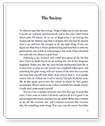Essay Instructions: Week 8 Assignment 2
Click the link above to submit your assignment.
Assignment 2: Presentation of a Research Article
Due Week 8 and worth 230 points
Using the research article from Assignment 1, outline the key components and findings of the study for use as a presentation outline. Consider your classmates and your professor as your audience for this presentation.
Write a two to three (2-3) page outline in which you:
Identify and explain at least four (4) major points in your article.
Agree or disagree with the article?s findings and state why.
Include a paragraph that invites responses from the audience to share their thoughts about the article.
Determine what future research might be necessary on this topic to increase the body of knowledge.
Your assignment must follow these formatting requirements:
Be typed, double spaced, using Times New Roman font (size 12), with one-inch margins on all sides; citations and references must follow APA or school-specific format. Check with your professor for any additional instructions.
Include a cover page containing the title of the assignment, the student?s name, the professor?s name, the course title, and the date. The cover page and the reference page are not included in the required assignment page length.
Article review
Herdt, G. (2004). Sexual development, social oppression, and local culture. Sexuality Research
& Social Policy, 1(1), 39-62. doi:10.1525/srsp.2004.1.1.39
One of the most contentious debates in the field of psychology today is the question of nature versus nurture, or the extent to which biology influences personal psychology versus cultural constructs. Although it has fallen out of favor somewhat, there is also the Freudian ?essentialist? argument, which suggests that certain mental models span across cultures. According to the article, ?Sexual development, social oppression, and local culture,? traditional theories of adolescent development have emphasized the importance of the individual, and focused upon the creation of an adult self as if it existed outside of culture in both the Freudian and biological discourses of psychology. Herdt (2004) conducts a review of Freudian and developmental psychology, to argue for a more culturally-informed understanding of the progression of adolescent development.
In the field, a philosophy of individualism has been privileged, and isolated adolescent development from the community. ?Historically, sexuality research as well as policy have consistently emphasized the individual, not the culture, sometimes to the extent that it appeared as if people lived outside of time and space (Herdt 2004: 39-40). The discipline of developmental psychology and psychoanalysis) reduces ?sexual desire, behavior, infection, and health were viewed as resulting from internal drives, and variably as signs of personal or moral weakness, biological fitness, or successful reproductive health or morbidity? (Herdt 2004: 40). Herdt is particularly interested in understanding the profound effect that social oppression can have upon an adolescent?s adolescent development. This is a particularly notable deficit regarding the impact that the unique nature female development, non-heterosexual desire and poverty can have upon shaping adolescent behavior.
This privileging of the individual in the field of psychology has its origins in Freudianism. Freud stressed the internal, trans-cultural nature of developmental conflicts such as the Oedipal and Electra Complexes. Adapters of Freud?s theories such as Erik Erikson still emphasized the universality of the stages of conflict, even though Erikson deemphasized sexuality as the only shaping force in the development of the human personality. The Freudian, psychological model was questioned by the Margaret Mead?s controversial conception of culturally-determined sexuality in Samoa. However, partially because of the discrediting and the limits of Mead?s study, in popular culture, adolescent sexuality remains seen as hormonally driven and ?essential.?
Biological theories of development have somewhat replaced Freudian ones, says Herdt, but they are likewise essentialized: ?a tendency in research about sexual orientation to sloppy and scientifically dubious thinking, resulting in a variety of special claims, for example, about the existence of a ?gay brain?? without asking how ?gayness? is socially constructed (Herdt 2004: 42). Either way, these are ?grand narratives? that attempt all-encompassing explanations of how and why the human brain develops. Freud did not engage in cross-cultural comparison because he assumed that his repressive hypothesis of childhood sexuality was common to all cultures but much of cross-cultural analysis still uses Western categories of sexuality, sex and gender.
This another reason why anthropological perspectives have not fundamentally shifted essentialized psychological and psychoanalytic conceptions of development: ?Too much emphasis in anthropological theories of sexuality was placed upon sex as an individual biological need or as an imperative to reproduce...heterosexual development was equated to marriage, with extramarital affairs treated as matters of individual sexual drives and ?personality adjustments,? not unlike the perspective of the psychoanalysts?? (Herdt 2004: 46). Margaret Mead, in her effort to show the culturally-constructed nature of sexuality, focused on sexuality as a discrete and separate category that was not necessarily really applicable to the Samoan perspective from an insider?s perspective.
The problem with both the psychological and the anthropological models of adolescent development is that they assume a ?normative? path for all, from which any deviation is abnormal. Yet ?sexual cultures create moral worlds that strongly inflect the meaning of sexual development and place children and adolescents whose sexuality is outside of the norm at risk. Theories of sexual development typically describe ?normative? processes that assume an ?all things being equal? epistemology of social resources and community development? (Herdt 2004: 55). It is just as important to question the cultural constructions of what is normal as it is to study them. Normality is a construct that varies from culture to culture, and even if human biology may be constant, how the development of biological impulses are viewed?positively or negatively, through patriarchal or heterosexist terms?impacts how that development is experienced.
Herdt?s agenda is openly political, in his call for more compassionate treatment of persons who are oppressed as a result of their sexuality (such as gay adolescents) or because of their gender (such as women in many areas of the world). However, his viewpoint is also theoretical in nature, namely that the debate between nature and nurture is never absolute, given that the categories developmental and anthropological psychologists are looking at most often come from their (Western) culture and worldview. By looking at cultures that are different from our own, and how adolescents develop, researchers can learn a great deal, particularly if they do not stress ?sexuality? as a separate category from other areas of development. And it is also important to understand how social oppression and oppressive categorization can stunt or psychologically damage development on a macro scale in a manner that transcends individual psychosis.


